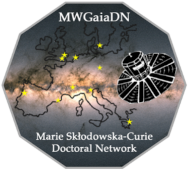Speaker
Description
Our goal is to determine which 100 nm wide wavelength region provides the most precise radial velocities between 800 and 2500 nm. For this reason, we generated 20,000 spectra with random Teff, logg, and [M/H] values at a resolution of 10,000, shifted their spectra by a random radial velocity between -100 and 100 km/s. Each spectrum was assigned a random SNR between 10 and 100 with a Gaussian noise pattern, and then re-derived their radial velocity values using the original spectrum without any noise. We checked the median offset and the scatter of the difference between the original and the new velocities. We find that the 1060-1160 nm region is the most optimal wavelength space to derive radial velocities, however the 1910 and 2010 nm window provides sufficiently precise radial velocities in a large effective temperature and metallicity range, with the advantage of the ability to probe the dust obscured regions of the Miky Way.

